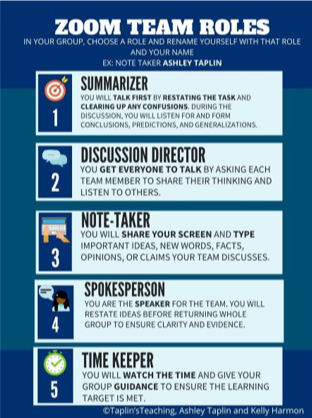Jigsaw and Synchronous Learning
- Rachel Mane

- Aug 24, 2020
- 3 min read

If you have heard of John Hattie and his visible learning study of effect size of instructional strategies and influences, then you have seen the jigsaw method. The jigsaw has an effect size of 1.2 or approximately 3 years growth in learning for a student. Woah! But such a highly effective strategy for a student can be very difficult to organize virtually. I have thought about how I typically used jigsaw in my math classroom and what that would look like through synchronous learning virtually.
In past years I have handed students an index card upon entry into the classroom. On this index card was a number between 1 and 5 and a colored sticker. The number indicated the first group students would be collaborating with and the color marked the second group they would rotate into. In the first group students would be working collaboratively on a certain problem or problem type. I would give direction for them to become experts on that problem to explain to the others how to solve or why they chose to solve that way. When they would rotate to the next group each student was prepared to yield questions from classmates and explain their thinking.
In the second color group there would be at least one student from each of the numbered groups to explain. This groups role was to complete the picture or “puzzle” by each member explaining their part from the first group. I would explain to this group they should go in order of the problem numbers and give everyone an equal amount of time to speak and answer questions. By the time was up each member should have contributed to learning the whole picture based on each individuals responses.
The jigsaw method can be so valuable for not only problem solving but sharing important information from articles and making connections amongst topics. Here is how I envision jigsaw through synchronous learning time.
First- groups students into their number break out rooms. Typically groups should have no more than 5 students in them but it depends on your class size. Make sure students are aware of their group number and make note of it. In each group have students select breakout room roles similar to the ones shown here from Ashley Taplin of taplinsteaching.

Be sure students are clear on what they are collaborating on together in this first jigsaw group. If their goal is to explain a problem solving method, have the notetaker make note of that. Give the break out room a time limit that is reasonable to not only complete the task together but discuss what they will share with their next jigsaw group.
While students are collaborating in their first number group you can be preassigning the second breakout rooms by color. Make sure each color break out room has atleast one representative from each numbered group. If you are using zoom for synchrounous learning you can preassign break out rooms and import a list from an excel file. This helps manage the break out room changes in advance of the class.

You can allow the students to return to the main room and share any thoughts or overall question they have from their first group before moving to the next room.
Once you are ready for the color jigsaw groups you can send the students to the break out rooms. Be sure they select roles and an order in which they will be sharing their information with one another. This break out room may require more time than the first since all students have the opportunity to share their expertise from their first group as well as answer any questions from their classmates. By the end of the break out room, students should have the full picture from each numbered jigsaw group.
Some ideas of what students can be collaborating on during jigsaw learning in a math class are solving a set of problems using different problem solving strategies such as graphing, making a picture, algebraically etc. They can be comparing different function types and the characteristics of each and when they move to their second jigsaw group they can make overall generalizations of functions. Students can be creating a problem together that is built from certain criteria given and when they move to their second group they share their problems and compare similarities and differences between them.
There are many awesome uses for the jigsaw method and I hope teachers and instructors can find way to utilize this method virtually!

Comments